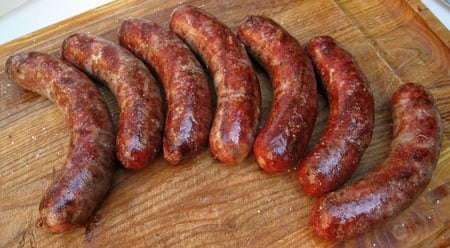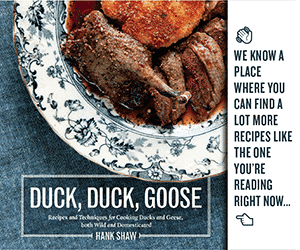
Toulouse sausages are the classic ingredient in cassoulet, that hearty bean, confit and pork extravaganza that is a hallmark of any self-respecting French cook’s repertoire. Traditional Toulouse sausages are all pork, and are minced by hand rather than ground — a fine option I do myself from time to time.
But the sausage is also wonderful made with duck mixed with fatty pork, then run through your coarsest die on your food grinder. (Incidentally, this is a great recipe for snows or Canada geese.)
What makes a Toulouse sausage unique? First the coarseness of it, but also its simplicity: It requires black pepper and garlic, that’s all. Many versions, such as the one Paula Wolfert describes in her masterful The Cooking of Southwest France, include nutmeg.
Mine does, too, and if you can manage to grind your own nutmeg on the spot, you will notice a difference. Don’t be tempted to add other flavors here. These need to be simple.
Toulouse sausage is excellent grilled slowly over hardwoods, roasted gently in a 350°F oven, and, of course, as an element in cassoulet or other winter stews.
NOTE: If you are unfamiliar with making sausages at home, I wrote a good step-by-step on the technique over at my friend Elise’s site Simply Recipes. You can read it here.
Toulouse Sausage
Ingredients
- 3 pounds lean pork, duck or goose meat
- 2 pounds fatty pork shoulder or pork belly
- 1/2 cup white wine, chilled
- 33 grams Sea or kosher salt (about 2 tablespoons plus a teaspoon)
- 4 grams Instacure No. 1, about 1/2 teaspoon (optional)
- 25 grams chopped fresh garlic (about 2 tablespoons)
- 10 grams ground black pepper (about 2 tablespoons)
- 1/2 nutmeg, freshly grated (about 1 teaspoon)
- hog casings
Instructions
- Chop the meat and fat into chunks that will fit in your grinder, mince any skin you are using, then mix the salt, garlic and all the spices together and toss with the meat and fat. I like to do this a day before, storing the mix in the fridge. This helps the sausage bind better.
- When you are ready to grind, chill the meat and fat until it is almost frozen by putting it in the freezer for an hour or so. Take out some hog casings and set in a bowl of very warm water.
- Grind through your meat grinder (you can use a food processor in a pinch, but you will not get a fine texture) using the coarse die, somewhere from 6.5 mm to 8 mm. If your room is warmer than 69°F, set the bowl for the ground meat into another bowl of ice to keep it cold.
- Add the wine and mix thoroughly either using a Kitchenaid on low for 60 to 90 seconds or with your (very clean) hands. This is important to get the sausage to bind properly. Once it is mixed well, put it back in the fridge for 30 minutes or so.
- Stuff the sausage into the casings all at once. Twist off links by pinching the sausage down and twisting and spinning it, first in one direction, and then with the next link, the other direction. Or you could tie them off with butcher's string.
- Hang the sausages in a cool place for 4 to 12 hours (the colder it is, the longer you can hang them). If it is warm out, hang for one hour. Once they have dried a bit, put in the fridge until needed. They will keep for at least a week in the fridge.
- If you are freezing the sausages, wait a day before doing so. This will tighten up the sausages and help them keep their shape in the deep-freeze.
Notes
Nutrition
Nutrition information is automatically calculated, so should only be used as an approximation.

